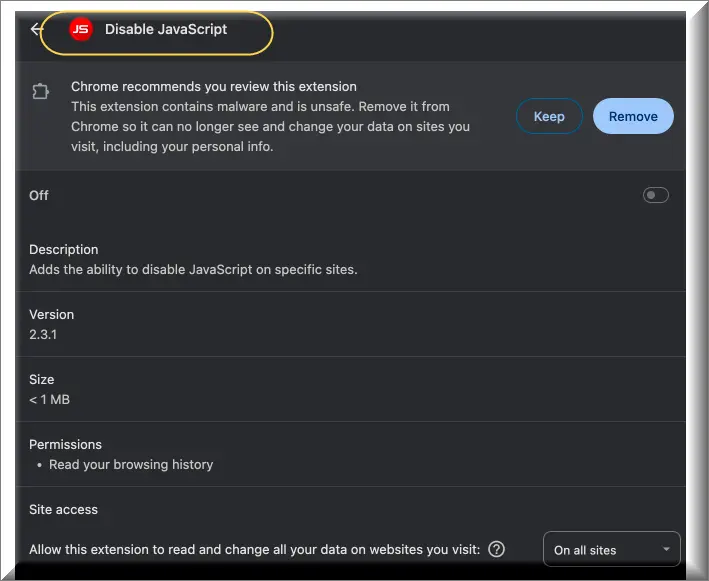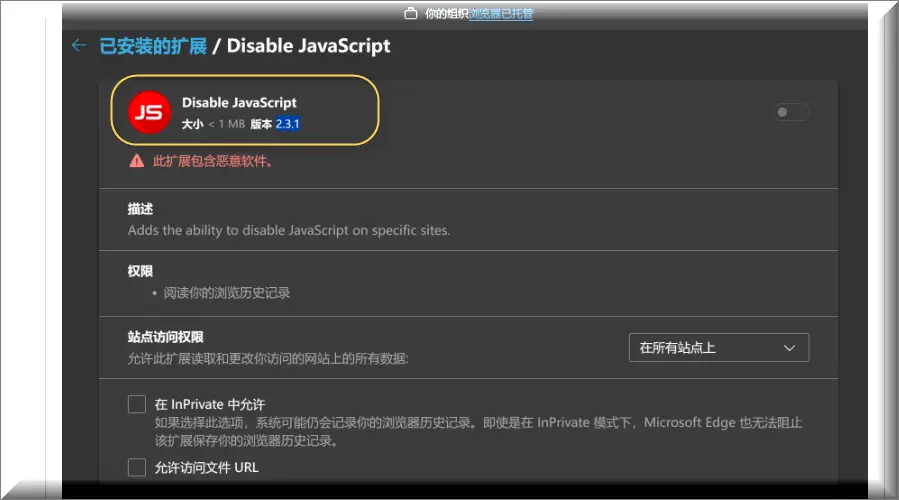In today’s digital age, browser extensions enhance user experience by providing added functionality to web browsers. However, these extensions can sometimes pose significant security risks, as seen in the recent discovery of malware within the “Disable JavaScript” extension. This incident raises critical questions about the safety of browser extensions and underlines the importance of vigilance among users. This article explores the “Disable JavaScript” malware issue, offering insights on how to recognize, avoid, and remove harmful extensions, and provides advice on safeguarding your computer against such threats.

Understanding the “Disable JavaScript” Extension
What is “Disable JavaScript”?
“Disable JavaScript” is a browser extension designed for Chrome and Firefox, allowing users to easily disable JavaScript on websites. Disabling JavaScript can enhance browsing speed, improve security, and reduce website clutter. However, the utility of such extensions can be compromised when they contain malware.

Discovery of Malware
The “Disable JavaScript” extension was found to contain malware and subsequently removed from the Chrome Web Store. Users were alerted to remove it due to its potential to access and alter data on visited websites, including personal information. Investigations revealed changes in the extension’s ownership and modifications to its code, raising suspicions about its safety.
Recognizing and Avoiding Extension Malware
Signs of Compromise
- Obfuscated Code: Legitimate extensions should have transparent, understandable code. The presence of obfuscated or minified code, especially when unnecessary, could indicate malicious intent.
- Unexpected Code Changes: Sudden changes in an extension’s code or functionality, particularly after ownership changes, warrant scrutiny.
- Unauthorized Data Access: Extensions requesting permissions not relevant to their stated functionality may be attempting to overreach for malicious purposes.
Staying Safe Online
- Regularly Review Extensions: Periodically check the extensions you’ve installed and remove those you no longer use or trust.
- Download from Reputable Sources: Only install extensions from well-known, official web stores and read reviews before installation.
- Stay Informed: Follow tech news to stay updated on compromised extensions and security advisories.
How to Remove “Disable JavaScript” and Other Malicious Extensions
- From Chrome:
- Navigate to
chrome://extensions/. - Locate “Disable JavaScript” or any suspicious extension.
- Click “Remove” to uninstall it.
- Navigate to
- From Firefox:
- Access
about:addons. - Find the extension in question.
- Select “Remove” or “Disable”.
- Access
- Perform a Security Scan: Use reputable antivirus software to scan your computer for any malware that might have been installed.
Post-Malware Removal Actions
Ensuring Your Security
- Change Passwords: If you suspect your data was compromised, change passwords for sensitive accounts.
- Log Out of Websites: Specifically for Facebook and LinkedIn, log out to invalidate session tokens that may have been captured.
- Monitor Account Activity: Keep an eye on account activity for unusual behavior indicating unauthorized access.
Leveraging Browser Security Features
- Update Your Browser: Always use the latest version of your browser, which includes the most recent security patches.
- Utilize Built-in Security Tools: Browsers often have settings that can enhance your security, such as blocking third-party cookies or disabling JavaScript by default on unknown sites.
Conclusion
The incident with the “Disable JavaScript” or Search Synergy extension serves as a stark reminder of the potential risks associated with browser extensions. By staying vigilant, regularly reviewing installed extensions, and adhering to best practices for online security, users can protect themselves from malware and maintain their privacy. Remember, the convenience offered by extensions should never come at the cost of your security.
SUMMARY:
| Name | Disable JavaScript |
| Type | Adware/Trojan |
| Detection Tool | Some threats reinstall themselves if you don't delete their core files. We recommend downloading SpyHunter to remove harmful programs for you. This may save you hours and ensure you don't harm your system by deleting the wrong files. |
Remove Disable JavaScript
To try and remove Disable JavaScript quickly you can try this:
- Go to your browser’s settings and select More Tools (or Add-ons, depending on your browser).
- Then click on the Extensions tab.
- Look for the Disable JavaScript extension (as well as any other unfamiliar ones).
- Remove Disable JavaScript by clicking on the Trash Bin icon next to its name.
- Confirm and get rid of Disable JavaScript and any other suspicious items.
If this does not work as described please follow our more detailed Disable JavaScript removal guide below.
If you have a Windows virus, continue with the guide below.
If you have a Mac virus, please use our How to remove Ads on Mac guide.
If you have an Android virus, please use our Android Malware Removal guide.
If you have an iPhone virus, please use our iPhone Virus Removal guide.
Some of the steps may require you to exit the page. Bookmark it for later reference.
Next, Reboot in Safe Mode (use this guide if you don’t know how to do it).
 Uninstall the Disable JavaScript app and kill its processes
Uninstall the Disable JavaScript app and kill its processes
The first thing you must try to do is look for any sketchy installs on your computer and uninstall anything you think may come from Disable JavaScript. After that, you’ll also need to get rid of any processes that may be related to the unwanted app by searching for them in the Task Manager.
Note that sometimes an app, especially a rogue one, may ask you to install something else or keep some of its data (such as settings files) on your PC – never agree to that when trying to delete a potentially rogue software. You need to make sure that everything is removed from your PC to get rid of the malware. Also, if you aren’t allowed to go through with the uninstallation, proceed with the guide, and try again after you’ve completed everything else.
- Uninstalling the rogue app
- Killing any rogue processes
Type Apps & Features in the Start Menu, open the first result, sort the list of apps by date, and look for suspicious recently installed entries.
Click on anything you think could be linked to Disable JavaScript, then select uninstall, and follow the prompts to delete the app.

Press Ctrl + Shift + Esc, click More Details (if it’s not already clicked), and look for suspicious entries that may be linked to Disable JavaScript.
If you come across a questionable process, right-click it, click Open File Location, scan the files with the free online malware scanner shown below, and then delete anything that gets flagged as a threat.


After that, if the rogue process is still visible in the Task Manager, right-click it again and select End Process.
 Undo Disable JavaScript changes made to different system settings
Undo Disable JavaScript changes made to different system settings
It’s possible that Disable JavaScript has affected various parts of your system, making changes to their settings. This can enable the malware to stay on the computer or automatically reinstall itself after you’ve seemingly deleted it. Therefore, you need to check the following elements by going to the Start Menu, searching for them, and pressing Enter to open them and to see if anything has been changed there without your approval. Then you must undo any unwanted changes made to these settings in the way shown below:
- DNS
- Hosts
- Startup
- Task
Scheduler - Services
- Registry
Type in Start Menu: View network connections
Right-click on your primary network, go to Properties, and do this:

Type in Start Menu: C:\Windows\System32\drivers\etc\hosts

Type in the Start Menu: Startup apps

Type in the Start Menu: Task Scheduler

Type in the Start Menu: Services

Type in the Start Menu: Registry Editor
Press Ctrl + F to open the search window

 Remove Disable JavaScript from your browsers
Remove Disable JavaScript from your browsers
- Delete Disable JavaScript from Chrome
- Delete Disable JavaScript from Firefox
- Delete Disable JavaScript from Edge
- Go to the Chrome menu > More tools > Extensions, and toggle off and Remove any unwanted extensions.
- Next, in the Chrome Menu, go to Settings > Privacy and security > Clear browsing data > Advanced. Tick everything except Passwords and click OK.
- Go to Privacy & Security > Site Settings > Notifications and delete any suspicious sites that are allowed to send you notifications. Do the same in Site Settings > Pop-ups and redirects.
- Go to Appearance and if there’s a suspicious URL in the Custom web address field, delete it.
- Firefox menu, go to Add-ons and themes > Extensions, toggle off any questionable extensions, click their three-dots menu, and click Remove.
- Open Settings from the Firefox menu, go to Privacy & Security > Clear Data, and click Clear.
- Scroll down to Permissions, click Settings on each permission, and delete from it any questionable sites.
- Go to the Home tab, see if there’s a suspicious URL in the Homepage and new windows field, and delete it.
- Open the browser menu, go to Extensions, click Manage Extensions, and Disable and Remove any rogue items.
- From the browser menu, click Settings > Privacy, searches, and services > Choose what to clear, check all boxes except Passwords, and click Clear now.
- Go to the Cookies and site permissions tab, check each type of permission for permitted rogue sites, and delete them.
- Open the Start, home, and new tabs section, and if there’s a rogue URL under Home button, delete it.


Leave a Comment